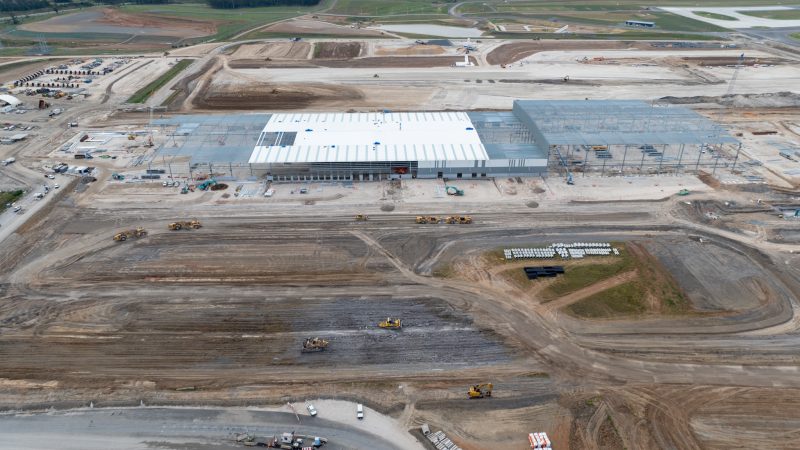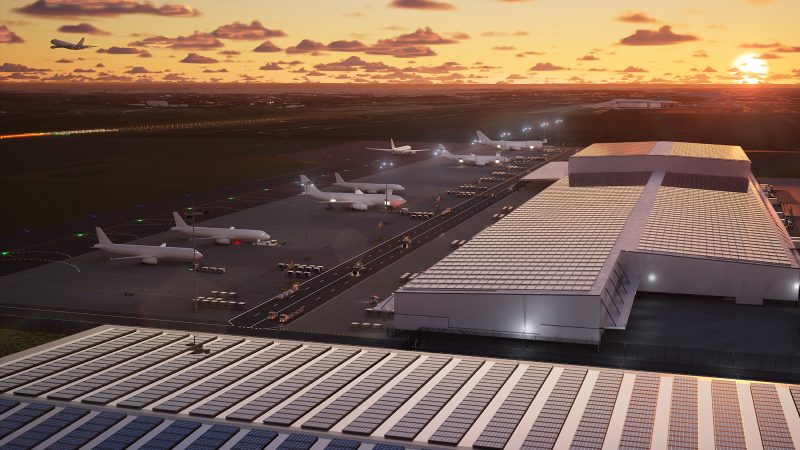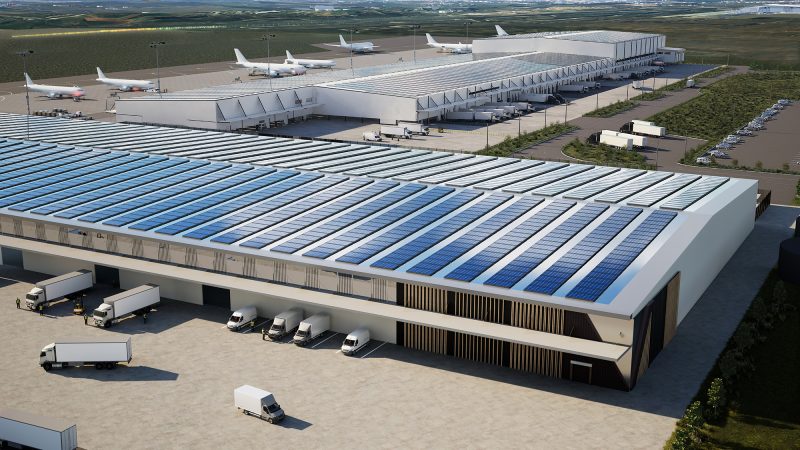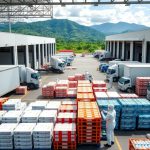Western Sydney International: A Gateway to Global Connectivity and Sustainability
Discover how Western Sydney International Airport is set to transform the region with its state-of-the-art Cargo Precinct, offering 24/7 operations, strategic advantages for exporters and a commitment to sustainability. Led by CEO Simon Hickey, this new hub promises to boost Sydney’s air cargo capacity, drive economic growth and provide seamless, eco-friendly travel experiences.
Western Sydney has long been a region rich in offerings, from its profound First Nations heritage to its vibrant and diverse community spirit.
With the opening of Western Sydney International (Nancy-Bird Walton) Airport in 2026, this cultural heartland will be more accessible to the world than ever before.
This new airport promises an experience unlike any other in Australia—seamless, sustainable, intuitive and exciting. It will be open around the clock for both international and domestic travel, as well as air cargo flights, ensuring constant connectivity.
As Australia’s newest airport, WSI is designed to enhance the passenger experience, making travel faster, easier and more reliable. Coupled with world-class digital capabilities, the airport aims to help airlines deliver flights that are on time and exceed expectations.
Leading the charge in this transformative project is Simon Hickey, the CEO of Western Sydney International Airport. He is dedicated to crafting an airport experience that’s not only seamless but also sustainable.
Hickey’s vision is to ensure that every aspect of the airport reflects these values, making it a welcoming gateway to Sydney’s vibrant cultural heartland.
Background and Development Timeline
It was around a decade ago that plans for the WSI airport were put in motion to satisfy the growing demand for aviation capacity in New South Wales.
As Sydney’s population and economy grew, it became evident that Sydney’s airport infrastructure would not be able to keep up with the demands of the increasing population.
Today, WSI is on its way to becoming one of the major airports in the region, with construction underway, and it is destined to become one of the busiest airports in the region.
The WSI Cargo Precinct
Upon its opening, the Western Sydney International (WSI) Cargo Precinct is set to revolutionize air freight in the region. Initially, it will have the capacity to handle at least 220,000 tons of freight annually, a significant boost underscored by the strategic advantage of 24-hour operations.
“This means the precinct will increase Sydney’s air cargo capacity by around a third on day one of operations,” explains Simon Hickey, CEO of Western Sydney International Airport.
However, this is just the beginning. The precinct is designed with growth in mind and future aims to expand its capacity to handle approximately 1.8 million tons of freight per year.
“WSI’s Cargo Precinct will become the center of air freight for the region,” Hickey emphasizes, highlighting its role in supporting both national and global supply chains.
The precinct is not only about increasing capacity but also about creating new opportunities. It will provide vital connections for various producers in New South Wales, enabling them to reach more customers worldwide.
“Our precinct will provide new connections for various NSW producers – allowing them to sell their products to more customers around the globe,” Hickey notes.
This expansion is expected to enhance the region’s economic landscape, offering local businesses unprecedented access to international markets and fostering growth across multiple sectors.
Driving Jobs and Economic Growth
Western Sydney International Airport’s Cargo Precinct is poised to be a significant driver of job creation and economic stimulation in the region.
“To date, WSI has supported thousands of jobs, and I’m delighted to confirm that the Cargo Precinct will be a major source of jobs into the future as well,” says Hickey.
The construction phase alone is expected to support up to 2,000 jobs, with more than 19,000 direct and indirect jobs anticipated annually across the precinct and its connected supply chains once operational.
This influx of employment opportunities will not only provide livelihoods but also invigorate the local economy.
“This new concentration of workers will help stimulate the growing economies of Western Sydney and Greater Sydney,” Hickey notes, emphasizing the positive ripple effects as people spend in local services, housing, transport, hospitality and retail sectors.
Major Market Signal: Strength of Opportunity at WSI
The Western Sydney International Airport’s Cargo Precinct is making significant strides in enhancing its operational capabilities by securing partnerships with major industry players.
“Securing Australia’s largest air freight services business in Qantas Freight sends a major market signal of the strength of the opportunity at WSI. This partnership underscores the precinct’s potential to become a central hub for air freight in the region.”
 In addition to Qantas Freight, the inclusion of Menzies Aviation, a world-leading airport services partner that handles over two million tons of cargo globally each year, further strengthens the precinct’s capabilities.
In addition to Qantas Freight, the inclusion of Menzies Aviation, a world-leading airport services partner that handles over two million tons of cargo globally each year, further strengthens the precinct’s capabilities.
“Menzies Aviation is another fantastic addition to our Cargo Precinct,” Hickey adds, highlighting the strategic advantage of having such a reputable partner on board.
These collaborations are pivotal in WSI’s efforts to assemble a precinct of top-tier industry players, which will significantly boost Sydney’s overall cargo capacity.
The precinct is designed for growth, and as demand increases, so too will its annual freight turnover. The terminal facility’s design and sophisticated materials handling equipment are key advantages for the future of air cargo operations in Sydney, ensuring seamless handling processes for both international imports and express domestic products.
Moreover, the Cargo Precinct is equipped to facilitate upgraded aircraft fleets for both domestic and international operators, offering enhanced capacity, flexibility, and operating longevity compared to the current operating environment. This positions WSI as a forward-thinking hub ready to meet the evolving demands of the air cargo industry.
Boosting E-commerce Growth
WSI’s Cargo Precinct will help facilitate the ongoing growth of e-commerce by providing an immediate uplift in Sydney’s air cargo capacity.
Situated in the heart of the ‘golden triangle’ of Brisbane, Sydney and Melbourne, the precinct is ideally positioned to serve the highest volume of end consumers in Australia.
The integration of high-volume systems that connect aircraft operations with road transport further enhances its capabilities, making it comparable to major global logistics operators. The precinct’s separation from the passenger terminal and direct connection to the upgraded Northern Road ensures efficient vehicle access, supporting seamless cargo operations.
“Add to all of this, the strategic advantages of WSI’s 24/7 operations,” which are crucial for meeting the demands of e-commerce and online retail, where efficient delivery times are essential. The reliability and punctuality of air cargo make it an asset for businesses looking to thrive in this fast-paced market.
Leveraging ‘Greenfield’ Status
Western Sydney International Airport’s greenfield status offers a unique advantage, allowing the team to “put their best foot forward from day one” without the need to retrofit aging infrastructure.
By consulting with industry and cargo operators, WSI has designed its Cargo Precinct and terminal facilities to support sophisticated handling equipment, ensuring efficient operations for all tenants.
The grid design accommodates heavy vehicles, reducing truck volume and handling times to maximize delivery turnover. Additionally, a dedicated access area for oversize cargo minimizes the impact on other trucks, streamlining operations further.
24/7 Operations
As a 24/7 operation, it provides importers and exporters with more choices, enabling them to reach new customers and strengthen existing partnerships, especially within the Asia Pacific region.
“One of Australia’s strengths is its primary producers, and WSI can support them by offering more accessible and flexible opportunities.”
For businesses exporting seafood or agriproducts, the advantages are clear.
“WSI’s 24-hour operations, central location, and strong transport connectivity mean those businesses can harvest products one day and have them on an overnight flight to lucrative fresh food markets in Southeast Asia the next morning.”
This flexibility and enhanced market access will also support other industries, such as pharmaceuticals.
Vitex Pharmaceuticals, based in Western Sydney, exemplifies this potential. With a significant portion of its workforce living locally, Vitex stands to benefit from the proximity of WSI’s Cargo Precinct to its warehouse operations.
“The new opportunities provided by our 24/7 schedules offer growing exporters like Vitex invaluable advantages.”
Commitment to Sustainability and Efficiency
“Our goal is to provide a safe and healthy workplace while supporting our customers’ sustainability targets,” Hickey emphasized.
One of the key features is the use of solar panels on both the terminal building and the Cargo Precinct to generate electricity. Additionally, WSI has implemented systems to harvest rainwater for recycled use across the airport precinct.
“We are committed to utilizing renewable resources wherever possible,” he added.
The airfield is engineered for efficiency, featuring rapid exit taxiways that reduce the average taxi times to around five minutes, thereby helping airlines save fuel.
“This design not only enhances operational efficiency but also contributes to fuel conservation.”
WSI is also supporting airlines in their transition to net zero by providing the capability to deliver sustainable aviation fuel (SAF) from the first day of operations.
As a member of the Sustainable Aviation Fuel Alliance Australia and New Zealand (SAFANZ), WSI is at the forefront of promoting sustainable aviation practices.
Furthermore, WSI has established a 117-hectare Environmental Conservation Zone, which is protected for the life of the airport.
“We are committed to environmental stewardship and have pledged to plant more than 2,500 trees and grasses in collaboration with local schools, the community, and the Rotary Club.
“WSI’s Cargo Precinct will include many features which align with our broad approach to sustainability across the airport’s construction and operations,” Hickey stated.
This commitment includes the installation of solar panels on both the terminal building and the Cargo Precinct to generate electricity, as well as mechanisms to harvest rainwater for recycled uses across the airport precinct.
The airfield is engineered for efficiency, featuring rapid exit taxiways that reduce average taxi times to around five minutes, helping airlines save fuel.
“We’ll also be supporting airlines’ transition to net zero, with the capability of delivering sustainable aviation fuel (SAF) to aircraft from day one of operations.”
As a member of the Sustainable Aviation Fuel Alliance Australia and New Zealand (SAFANZ), WSI is committed to promoting sustainable aviation practices. Additionally, a 117-hectare Environmental Conservation Zone is protected for the life of the airport, with a commitment to planting more than 2,500 trees and grasses in collaboration with local schools, the community, and the Rotary Club.
The strategic location of WSI’s Cargo Precinct is a major draw for international logistics companies looking to invest in Australia.
Strategic Advantages
Air cargo offers significant advantages over other modes of transport, particularly for high volume, high value and time-sensitive goods.
“The biggest advantages of air cargo are its efficiency—meaning items are on the shelf quicker and maintained at a high quality for longer—and, of course, the service reliability.
“These features, along with our long-term plans for growth, offer strategic advantages for agricultural producers”
The surrounding industrial lands are also under various stages of development by both public and private entities, including potential agribusiness proponents.
“This development once again demonstrates the strength of the opportunities offered by our airport and our Cargo Precinct,” Hickey concluded, highlighting the precinct’s role in fostering growth and investment in the region.
Box Out
WSI: A modern airfield designed for the 21st century
Due to ongoing discussions that remain commercial in confidence, specific details on customer terminal layout designs or technology use at Western Sydney International Airport (WSI) cannot be disclosed at this time. However, the following information outlines the benefits of WSI’s modern airfield design, which will support efficient air cargo operations.
Airfield Design for Efficiency
- Rapid Exit Taxiways: Built at a 45-degree angle, these allow aircraft to exit and enter the runway at faster speeds, reducing average taxiing time to around five minutes—significantly shorter than at other airports.
- Runway Surface: Grooved to enhance drainage, minimizing the risk of hydroplaning on wet surfaces.
- Aircraft Compatibility: Capable of handling the full range of commercial aircraft, including new ultra-long-haul airliners like the A350-1000 and Boeing 777X.
- Aeronautical Ground Lighting (AGL): Over 2,500 AGLs installed to ensure runway operations in low visibility conditions.
- High Intensity Approach Lights (HIAL): 348 HIALs provide directional, distance, and glidepath information for safe transitions from instrument to visual flight.
Digital Aerodrome Service (DAS)
- Innovative Control: WSI will be Australia’s first airport without a traditional air traffic control tower, operating as a digitized aerodrome.
- Advanced Technology: DAS provides more information and greater situational awareness to air traffic controllers, with over 20 high-resolution cameras monitoring the airport and airspace.
- Enhanced Features: Includes object tracking, night vision, and image enhancement, allowing controllers to see beyond human limitations.
- Infrared Cameras: Enable better visibility at night and during low visibility conditions.
CAT III-B Instrument Landing System
- Safe Operations: The runway will be equipped with a modern CAT III-B system, allowing aircraft to operate safely in foggy conditions.















